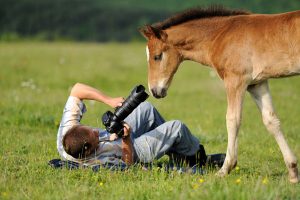Little gives me as much joy as capturing a wild and wonderful animal on camera, getting the moment just right, perfect light, exceptional angle, amazing grace caught just at the perfect time. Patience is required, so are knowledge and persistence and if you are serious about wildlife photography you will require stamina and a stoic calm. Moreover, you will need to become one with nature, make yourself disappear in its wonder, just to steal a picture.
To be a bit more practical about it, here are some tips on the approach to take:
Patience is a Virtue, Have it if You Can
Animals do what they like, they are not going to pose for you, they will look this way or that, ramble around, upset your lighting intentions and they will never try to look cute or fierce for your picture. The only thing you can do is be patient and make use of your waiting time by learning about the animal, its behavior, habits and eccentricities. Time spent in nature waiting for the perfect moment to take a picture is never wasted and there are many times i remember discovering things about animals that I would never have otherwise observed. I have spent days watching animals and it’s truly amazing how, after a few days, you can anticipate its moves and how you become so familiar with their little ways.
Practice on a Pet or in a Park
This may seem like a trivial suggestion, but taking good pictures of your dog while he is running, capturing a duck taking flight in the park or catching a bird in your backyard on camera is a valuable exercise and will give you a feel for wildlife photography before you venture into the wild.
Choosing the Right Locations
If you are going to take pictures in a national park, ask the ranger to tell you about the locations the animals visit and, if you are taking pictures elsewhere, find out from a local farmer or walking guide what the best observation spots are.
Research Your Animal
 Study your intended object in detail to find out its habits, preferences and routines, it will make finding and possibly approaching them a lot easier.
Study your intended object in detail to find out its habits, preferences and routines, it will make finding and possibly approaching them a lot easier.
Invest in a Good Camera
Investing in a decent lense is a must as wild animals are obviously quite shy and a good lense will allow you to take a picture without having to get to close. Carrying around a tripod for heavier cameras may be a bit of a pain but ultimately well worth it. I have heard of wildlife photographers who prefer resting heavy equipment on trees or rocks but in my opinion, this just brings restrictions and you are already doing a difficult job.
Being as unobtrusive as possible is a necessity, so be prepared to lie on the ground and crawl through shrubs and bushes for that perfect picture. Animals move fast which makes a fast shutter speed essential to your success and also removes any possible risk creating an unsteady image.
Respect & Awe
Regardless of whether you are trying to take a picture of a beautiful butterfly or an angry gorilla, respecting the animal is a must and will ensure both your own and the animal’s safety and welfare. No doubt you will be in awe of your subject but it may not feel the same way about you!
Dusk or Dawn
As a rule, animals are at their most active at dusk or dawn, nocturnal animals emerge, and most animals hunt and feed at those times. The fading or emerging light will also add a beautifully colored background to your picture.
Focus on the Eyes
Capturing the eyes of an animal greatly enhances the impression and adds depth to your picture. Adjust your lense accordingly and this will ensure that your picture is stunning to look at. The best animal photos are those that allow you to look straight into the animal’s eyes.
These are the basics of how to become a successful wildlife photographer and I have learned that time and patience as well as a good camera are the most vital ingredients in your recipe for taking top quality photographs that will delight you and those you share them with.
